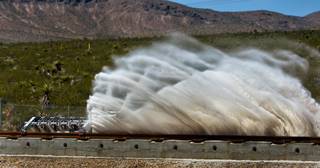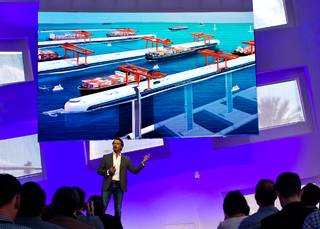The story of how Hyperloop One came to test its product in Nevada started 2,400 miles away in Washington, D.C., with a former top aide of President Barack Obama and a venture capitalist who heard firsthand of the hyperloop concept while traveling with SpaceX and Tesla CEO Elon Musk.
In 2013, Musk had outlined the hyperloop concept — a transportation platform that propels levitating pods down pneumatic tubes at speeds reaching 700 miles per hour — in a public white paper. Because the concept was public, time was an important factor, and Hyperloop One was in a race with other companies and developers. It needed a partner who could expedite a process that could take years.
Related news
Enter Nevada.
After running Obama's 2012 re-election, Jim Messina formed a consulting group that advised numerous companies, including technology startups like Uber and Airbnb. But he had also joined the board of Hyperloop One, known at the time as Hyperloop Technologies Inc. The company had come into existence after Shervin Pishevar, an early investor in Uber, heard about hyperloop from Musk.
In 2014, Messina set up a meeting with Senate Minority Leader Harry Reid and by December, Hyperloop One announced it would conduct testing of its platform at the Apex Industrial Park in North Las Vegas.
“Sen. Reid was incredibly supportive and … opened the doors to the mayor and then the governor. And the mayor and the governor have been very supportive,” Pishevar said of the meeting after a successful test at Apex Wednesday morning. “That’s why we’re here in Nevada building this.”
On Wednesday, about six months after its announcement that it would build an open-air test track in Nevada, Hyperloop One propelled a structural frame down that track at about 105 mph. The test was a significant moment for the company because it provided a validation of its technology.
Pishevar spoke and Messina watched, as did a number of the Nevada officials, many sitting under shaded bleachers, flanked by a large television screen. More than 100 guests, required to take a bus from the Las Vegas Strip because the test site is so remote, had been driven to the hyperloop test site.
Before and after the test, multiple executives for Hyperloop One stressed the role Nevada has played and is expected to play in the company going forward. Much of that, CEO Rob Lloyd said in an interview, had to do with a supportive government that worked to meet Hyperloop's ambitious timeline.
Hyperloop One recently received land-use approval from the Bureau of Land Management, a process that Lloyd said could take years. Clark County helped with the permitting process, the city of North Las Vegas provided a large land asset, and the state quickly approved tax incentives for the company.
“We’ve never really seen support from government that has made something that could take two years happen in three months,” said Lloyd, a former president of Cisco Systems. “And that’s pretty cool.”
The feelings are mutual. As much as Hyperloop One benefits from the responsiveness of state officials, those officials benefit from the firm’s presence, which they tout as an economic development win.
“We believe that Hyperloop One will develop the next mode of transportation while also providing a significant revenue stream and job opportunities for Nevadans,” Gov. Brian Sandoval said in a statement prior to the test, adding that the company “will be an anchor at the Apex Industrial Park.”
Clark County Commissioner Marilyn Kirkpatrick said that the county’s ability to help guide businesses through permitting, as it did for Hyperloop One, is important for luring future businesses to the county.
“In six weeks, we were able to get them where they are today,” Kirkpatrick said of the county’s role. “That’s important to existing businesses as well as new businesses that are coming here.”
And North Las Vegas Mayor John Lee said Hyperloop One’s presence could spur more development at Apex, which has had difficulty attracting developers in past years because utilities there are sparse. Lee hopes that with the presence of Hyperloop One and Faraday Future, an electric car company that is building a $1 billion manufacturing factory at Apex, the ability to bring companies there will accelerate.
“We’ve started with the cream of the crop,” Lee said.
Hyperloop One wants to transport cargo by 2019 and people by 2021. Executives with Hyperloop One bill it as a safer and more efficient alternative that could transport passengers the 350 miles from Los Angeles to San Francisco in about 30 minutes. Some experts, however, remain unsure of how quickly the company will be able to bring a product to market. James Moore II, director of the University of Southern California’s Transportation Engineering Program, cited a maze of public policy issues that it would have to navigate. Those include issues concerning safety, financing and land ownership.
“I would certainly not say nothing will come of hyperloop technology,” Moore said. “But I doubt this specific piece of technology will have a dramatic effect on how we move people and goods in the near term.”
And the startup is not without competition. It is one of two companies racing to build the first hyperloop platform. The other startup firm, Hyperloop Transportation Technologies, is testing in California.
The track that the company tested on Wednesday was about 57 meters, or about 60 yards. In the coming months, Hyperloop One plans to build a two-mile track on more than 13 acres of additional land it owns at Apex. It also confirmed on Wednesday that it is building a manufacturing facility in the city of North Las Vegas. With these projects, the company said it plans to invest more than $121 million and create about 100 jobs. That made it eligible for $9.2 million in tax incentives, which a state board approved in March.
Reid also introduced Hyperloop One to Anthony Marnell, the Las Vegas resort developer and chairman of XpressWest, which is building a high-speed rail system linking Las Vegas with Los Angeles. Lloyd, Hyperloop One’s CEO, said he could envision opportunities to work with XpressWest in the future.
“We keep thinking there’s a neat opportunity there but nothing that we are in a position to talk about right now,” Lloyd said. “We are right in the backyard of North Las Vegas here so we are always interested in doing something that would take hyperloop and make it a production reality in Nevada."
By the end of December, it plans to have tested a prototype of the system in North Las Vegas.
“This is where Hyperloop is getting invented,” Brogan BamBrogan, a co-founder, said on Wednesday.


